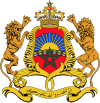Economic history of Morocco
| Macroeconomic indicators | |
|---|---|
| GDP (PPP) | US $148.1 billion (2009 est.) |
| GDP growth | 5.7% (2009 est.) |
| GDP per capita PPP | US $4,725 (2009 est.) |
| GNI(PPP) per capita | US $3,990 (2009 est.) |
| Inflation (CPI) | 4,6% (2009 est.) |
| Gini index | 40.0 (2005) |
| Unemployment | 2,1% (2008) |
| HDI |
|
| Labor force | 11.5 million (2008 est.) |
| Pop. in poverty | 15% (2008) |
The economic history of Morocco has largely been charted by the national government through a series of five-year plans. Centralized planning has gradually given way to moderate privatization and neo-liberal economic reforms.
In the 20th century a lot of firms in the Arabic world were run by the government. This was due to the objective to mitigate the influence of foreigners and minorities that frequently ran the firms. Other reasons included the lack of human capital as well as the special characteristics of oil production economies. Regarding the human skills Morocco lagged behind; the years of schooling as a representation of the level of human capital did not increase much in Morocco in the beginning of the 20th century (from almost 0 years of schooling in 1880 to around 1.6 in 1950). Even compared to other North African countries Morocco was worse off. So this lack of school education was a difficult barrier for developing a class of entrepreneurs.
Morocco instituted a series of development plans to modernize the economy and increase production during the 1960s. Net investment under the five-year plan for 1960 to 1964 was about $1.3 billion. The plan called for a growth rate of 6.2%, but by 1964 the growth rate had only reached only 3%. A new three-year plan (1965 to 1967) targeted an annual growth rate of 3.7%. The plan emphasized the development and modernization of Morocco's agricultural sector. The five-year development plan for 1968 to 1972 called for increased agriculture and irrigation. The development of the tourist industry also figured prominently in the plan. The objective was to attain an annual 5% growth rate in GDP; the real growth rate actually exceeded 6%.
Investment during the 1970s included industry and tourism development. The five-year plan for 1973 to 1977 envisaged a real economic growth of 7.5% annually. Industries singled out for development included chemicals (especially phosphoric acid), phosphate production, paper products, and metal fabrication. Tourist development was also stressed. In 1975, King Hassan II announced a 50% increase in investment targets to allow for the effects of inflation. The 1978 to 1980 plan was one of stabilization and retrenchment, designed to improve Morocco's balance-of payments position, but the 4% annual growth rate achieved was disappointing.
The ambitious five-year plan for 1981 to 1985, estimated to cost more than $18 billion, aimed for a growth rate of 6.5% annually. The plan's principal priority was to create some 900,000 new jobs and to train managers and workers in modern agricultural and industrial techniques. Other major goals were to increase production in agriculture and fisheries to make the country self-sufficient in food, and to develop energy (by building more hydroelectric installations and by finding more petroleum and other fossil fuels), industry, and tourism to enable Morocco to lessen its dependence on foreign loans. The plan called for significant expansion of irrigated land, for increased public works projects such as hospitals and schools, and for economic decentralization and regional development through the construction of 25 new industrial parks outside the crowded Casablanca-Kénitra coastal area. Proposed infrastructural improvements included the $2-billion rail line from Marrakech to El Aaiún; a new fishing port at Ad-Dakhla, near Argoub in the Western Sahara; and a bridge-tunnel complex across the Strait of Gibraltar to link Morocco directly with Spain. Large industrial projects included phosphoric acid plants, sugar refineries, mines to exploit cobalt, coal, silver, lead, and copper deposits, and oil-shale development.
...
Wikipedia

